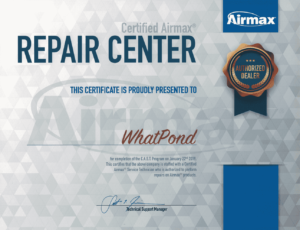With Sandy bearing down on the East Coast, wind and rain are the major threats, with an emphasis on a lot of rain.
With this in mind, pond owners should check out their safety devices on their ponds starting with the emergency spillway. Be sure it is free from debris, sticks, and logs, leaves even floating toys or devices. Check it now and during the storm to be sure no other debris has been blown into, or washed into the pond.
The down pipe, stand pipe or also called the overflow pipe needs to be watched too. If you have a screen on the pipe be sure to keep it clear if you have no protection on the pipe please monitor the pipe to be sure it is free from any debris that could plug the pipe and allow the water to rise. If there is debris be extremely careful cleaning the debris from the pipe or screen. There is a lot of water racing into the pipe and you could be sucked in or caught in the vacuum and become stuck. Keep a safe distance and use a long pole to remove debris. If you are using a boat to remove debris don’t just float out to clean it off. Anchor a rope on shore and let yourself drift in the wind to the point where you can reach the pipe. We don’t want the wind blowing the boat into the pipe and take a chance of breaking it or moving it.
The watershed should also be watched, whether it is field drainage or a stream keep an eye out for any build up or even damming of debris that could release and over fill the pond in a short amount of time. It doesn’t take much for a twig or branch to start collecting leaves or other twigs and hold back water. Once there is too much weight of water that branch that started it all could break and flood into the pond with too much water too quick and all the debris that comes with the water.
And by all means wear protection whether in a boat or wading out, get the life preserver on. And be sure you have a helper to either help you in case of trouble or able to get help if something should go wrong. Don’t do this alone. I’ve even tied myself off with a partner holding the rope only going out 3’ from shore. The pond floor is slippery and the water is cold, emergency services could be overwhelmed in the coming days or the road to your place could be flooded and they can’t reach you.
Are you able to lower the pond level, get water out of the pond for the anticipated coming rain fall or even snow melt for that matter. If it is possible to lower the water level this can be another assurance to protect the dam and limit too much water flow out the emergency spillway.
Accidents do happen don’t become a statistic we and your pond want you around to enjoy the next season.
All I’m saying is be careful, watch your pond and if you don’t feel confident to do any of the above don’t attempt to do it.
Just another thought about your pond, what would happen if the dam let go? Will it just flood your own field and run off from there or will it have an impact on the neighbor’s property or other structures downstream? If the dam should let go and other folks are in the way of flooding please let them know in advance of the potential hazards.
Alrighty then I’m getting off the stand and sorry if this seems too straight forward but anything can happen so prepare for the worse, keep an eye on the pond. That’s what we do in our CERT program and the EOC, learn, plan and prepare and pray we don’t need to use our skills or be activated.

